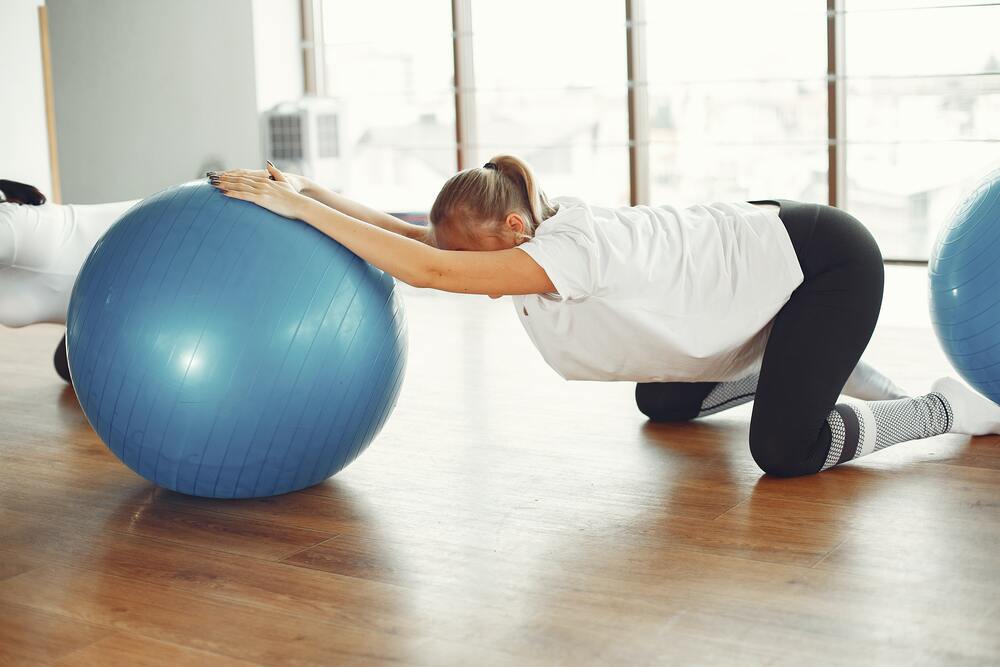
Are you pregnant and looking for a safe and effective way to exercise? Yoga during pregnancy can be a great way to stay active and prepare for childbirth. And if you’re incorporating a yoga ball into your practice, it’s important to choose the right size for your body.
Choosing what size yoga ball for pregnancy, it’s important to consider your height and weight to find the appropriate size ball.
Generally, the recommended size for most pregnant women is a 65 cm ball. However, if you are shorter than 5’4″ (162 cm), you may want to consider a 55 cm ball, and if you are taller than 5’10” (178 cm), you may want to consider a 75 cm ball.
It’s a good idea to choose a ball that is made from anti-burst material to ensure safety. As always, it’s best to consult with your healthcare provider before beginning any new exercise routine during pregnancy.
Choosing What Size Yoga Ball For Pregnancy

Choosing the right size yoga ball is important, especially during pregnancy when you want to ensure the safety and comfort of both you and your baby. Here are some factors to consider when choosing a yoga ball:
Height
Your height is one of the most important factors in determining the size of the yoga ball you need. A ball with a diameter of 65 centimeters is suitable for most expectant mothers.
- Short: If you’re under 5’4″ (162 cm), a yoga ball with a diameter of 55 cm is recommended.
- Average: For those between 5’4″ (162 cm) and 5’10” (178 cm), a 65 cm ball is typically appropriate.
- Tall: If you’re over 5’10” (178 cm), a larger ball with a diameter of 75 cm is often recommended.
| Height | Size | Recommended Ball |
| Short | Below 5’4″ (162 cm) | 55 cm |
| Average | Between (162 cm) and 5’10” (178 cm) | 65 cm |
| Tall | Above 5’10” (178 cm) | 75 cm |

Weight
Your weight is another important factor to consider. If you weigh more than 250 pounds (113 kg), you may want to consider a larger ball, such as a 75 cm ball, to ensure stability and safety.
Body type
Your body type can also affect the size of the yoga ball you need. If you have a shorter torso or shorter legs, you may want to consider a smaller ball to ensure proper alignment and support during exercise.
Comfort
Ultimately, the size of the yoga ball you choose should be comfortable for you to use. If you feel unstable or uncomfortable on the ball, try a different size until you find the one that feels right for you.
Also read about: Can We Drink Lemon Water Before Yoga?
Negative impacts of using improperly sized yoga
Using an improperly sized yoga ball during pregnancy can have the following negative impacts:
- Instability and falls: If the yoga ball is too small or too large for your body size and weight, it can lead to instability and an increased risk of falling while using the ball for exercises or sitting. Falls during pregnancy can pose a risk to both you and your baby.
- Discomfort and poor posture: If the yoga ball is too small, it may not provide adequate support for your body, leading to discomfort and poor posture. This can put unnecessary strain on your back, hips, and joints.
- Lack of pelvic support: A yoga ball that is too small may not provide proper support to your pelvic area, which is important during pregnancy. Insufficient support can lead to discomfort or even exacerbate conditions like pelvic girdle pain or pelvic instability.
Benefits of yoga in pregnancy
Yoga offers numerous benefits for pregnant women, both physically and mentally. Here are some key benefits of practicing yoga during pregnancy:
Physical well-being
- Improved strength and flexibility: Yoga poses help strengthen the muscles needed for labor and childbirth, such as the pelvic floor, abdominal muscles, and back muscles.
- Alleviation of common discomforts: Yoga can help reduce pregnancy-related discomforts like back pain, sciatica, swollen ankles, and tightness in the hips.
- Enhanced circulation and lymphatic flow: Gentle movements and stretches in yoga help improve blood circulation and lymphatic flow, aiding in reducing swelling and promoting overall well-being.
Emotional and mental well-being
- Stress reduction: Yoga incorporates breathing techniques and mindfulness practices that can help reduce stress, anxiety, and promote relaxation.
- Improved sleep: Regular yoga practice can contribute to better sleep quality and help alleviate insomnia or sleep disturbances common during pregnancy.
- Bonding with the baby: Yoga provides an opportunity for expectant mothers to connect with their growing baby, fostering a sense of closeness and emotional bonding.
Preparation for labor and childbirth
- Breath awareness and control: Yoga teaches deep breathing techniques that can be beneficial during labor, helping to manage pain and promote relaxation.
- Increased body awareness: Through yoga, pregnant women develop a deeper understanding and connection with their bodies, which can be empowering during childbirth.
- Pelvic floor strengthening: Specific yoga exercises, such as Kegels and pelvic floor exercises, can help strengthen the pelvic floor muscles, aiding in labor and postpartum recovery.
FAQs
Conclusion
In conclusion, choosing the right size yoga ball is important for ensuring safety and comfort during prenatal yoga. Your height, weight, and body type should be taken into consideration when selecting a ball. A ball that is too small or too large can be uncomfortable and potentially unsafe.
By following the guidelines for selecting the appropriate size ball, you can support your practice and optimize your prenatal yoga experience. As always, be sure to consult with your healthcare provider before beginning any new exercise routine during pregnancy.

